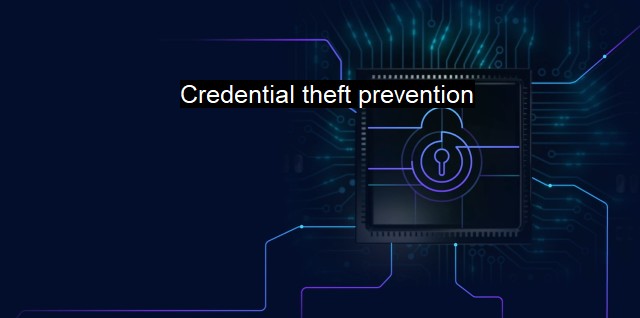What is Credential theft prevention?
Protecting Yourself from the Growing Threat of Credential Theft: Effective Prevention Techniques for Individuals and Organizations
Credential theft prevention refers to the strategies, technologies, and practices implemented to prevent unauthorized access, acquisition, or usage of sensitive and confidential information such as usernames, passwords, banking codes, social security numbers, etc. this concept is crucial as illicit activities such as identity theft, fraud, and unauthorized system access frequently hinge on stolen credentials.Credential theft is a significant issue, responsible for several high-profile security breaches resulting from inadequate protection or lax security measures. Even in sophisticated digital landscapes, playing down the danger of credential theft can have baleful consequences including substantial financial losses, reputation damage, and massive data leaks.
Preventing credential theft necessitates an understanding of numerous methods exploited by cybercriminals. One of the most prevalent techniques is phishing, where the attacker impersonates a trusted entity to trick individuals into disclosing their login credentials. Malware is another danger, a malicious software often proliferated through email attachments, malvertisement, and compromised websites to steal credentials directly from users’ devices. Then there is credential stuffing, where stolen credentials are used to breach multiple accounts due to users’ habit of reusing passwords. Notorious types of malware for credential theft include spyware, keyloggers, and banking Trojans.
To counter these threats, a variety of measures can be implemented to successfully boost credential theft prevention. Keeping system software updated is one essential practice, as updates frequently include patches for the latest discovered vulnerabilities that could be exploited for credential theft.
Using stronger authentication systems also assists in this prevention. With Multi-Factor Authentication (MFA), even if credentials were stolen, they could not access the system without another factor such as a physical mobile device or fingerprint scanner. Biometric data such as fingerprints or facial recognition marks, are a strong alternative for security, as they are nearly impossible to duplicate digitally.
Encouraging and enabling the creation of stronger credentials also comes in handy. Password policies that enforce the employment of long, complex passwords including alphanumeric and special symbols effectively curtail credential theft due to the heightened difficulty of breaking such passwords.
To mitigate the damage when credential theft does occur, it is important to monitor system access and activity. Unusual activity can stand as an early warning signal for stolen credentials. Protocols should also be in place for the immediate response if a breach occurs such as changing passwords across accounts, increasing monitoring activity, and where necessary, alerting appropriate legal authorities.
Credential theft prevention is incomplete without regular user training and awareness campaigns. It is important to educate individuals about secure practices like not sharing credentials, employing different passwords for different systems, recognizing and avoiding phishing attempts, and reporting suspicious activity.
In the same vein, organizations must actively use antivirus software that can intelligently trap and neutralize threats before they make contact with sensitive information. Firewall systems also prevent unauthorized access to system resources, deterring potential credential theft.
Last but not least, encryption and anonymization support credential theft prevention efforts. Encryption disguises credentials, making them unreadable to thieves, while anonymization strips sensitive data of any identifiable features, reducing the usability of stolen credentials.
As the digital landscape continues to blossom and with it, the increasing inevitability of cybercrime, credential theft prevention becomes progressively important. Multi-faceted strategies including regular system updates, robust user education, and advanced security measures are needed to ensure the sanctity and confidentiality of critical digital credentials. Our cornerstones for building cybersecurity must be vigilance, unceasing education, and readiness to adapt to new threats.

Credential theft prevention FAQs
What is credential theft prevention?
Credential theft prevention is the practice of implementing security measures to protect sensitive information, such as usernames and passwords, from being stolen by cybercriminals.Why is credential theft prevention important?
Credential theft is a common way for cybercriminals to gain access to systems and data. If they are able to obtain usernames and passwords, they can use them to further infiltrate a network or gather other sensitive information. Implementing credential theft prevention measures can help reduce the risk of data breaches and protect sensitive information.What are some examples of credential theft prevention measures?
Some examples of credential theft prevention measures include implementing strong password policies, using two-factor authentication, regularly updating antivirus and anti-malware software, conducting regular security training for employees, and conducting regular security audits.What should I do if I suspect my credentials have been stolen?
If you suspect your credentials have been stolen, it is important to act quickly. Change your passwords immediately and monitor your accounts for any suspicious activity. Contact your IT department or a cybersecurity professional to report the incident and get help with securing your accounts and preventing further damage.| | A | | | B | | | C | | | D | | | E | | | F | | | G | | | H | | | I | | | J | | | K | | | L | | | M | |
| | N | | | O | | | P | | | Q | | | R | | | S | | | T | | | U | | | V | | | W | | | X | | | Y | | | Z | |
| | 1 | | | 2 | | | 3 | | | 4 | | | 7 | | | 8 | | |||||||